Aftermath of Mauthausen Liberation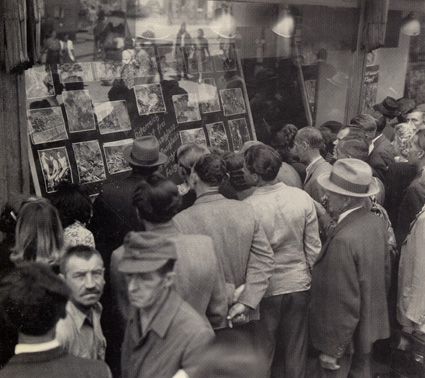 After the liberation of the Mauthausen concentration camp and its sub-camps, the Allies had the task of politically rehabilitating the Austrian people by informing them of the atrocities committed by the Nazis and their hero, Adolf Hitler. The following quote is from Gordon J. Horwitz, who wrote a book entitled "In the Shadow of Death": Many Austrians preferred to deflect responsibility for Nazi crimes onto their more powerful neighbor, Germany. The photograph above shows citizens of Linz, Austria looking at a display of photographs taken by the Americans after the liberation of Mauthausen and its sub-camps. The photos show the starving prisoners and the emaciated bodies of the victims who had died from typhus. Coal to fire the cremation ovens was in short supply, so the bodies had been stacked up outside the barracks. According to the survivors, the Soviet Prisoners of War were engaging in cannibalism, biting chucks of raw flesh out of the corpses. The survivors also described how rats were gnawing on the dead bodies, making them unrecognizable. 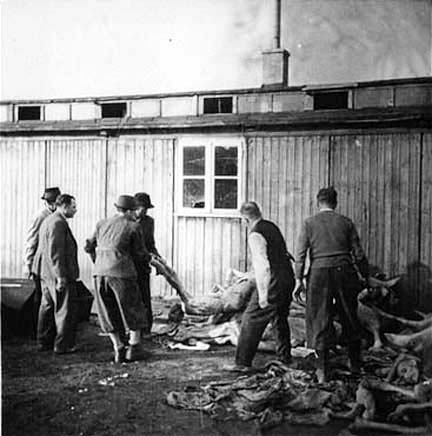 The photograph above shows Austrian civilians who were brought to the camp to bury the bodies of prisoners who died in the Russian POW camp, which had been converted into a camp for sick prisoners. A typhus epidemic was raging in the camp and as many as 300 prisoners were dying each day. According to Holocaust historian Martin Gilbert, there were 3,000 prisoners who died after the liberation, before the typhus epidemic could be brought under control. The American liberators used DDT to kill the lice in the camp; typhus is spread by body lice. 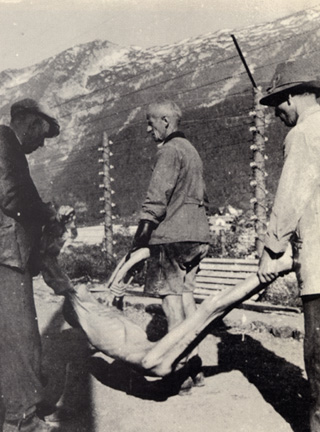 In the photograph above, an Austrian civilian (center) is dressed in lederhosen and Tyrolean jacket as he carries an emaciated body to a burial site at one of the sub-camps. Note that he is wearing gloves, something which was forbidden by the American liberators, since the purpose was to punish the Austrian civilians by forcing them to handle the diseased bodies without protection. According to Raymond Buch, one of the American liberators of Mauthausen, the Austrian civilians from the nearby towns were ordered to come to the camp, wearing their Sunday best clothes. This policy was not unique to Mauthausen. General Dwight D. Eisenhower ordered that as many civilians as possible should be brought from the nearby towns to view the carnage in the Nazi concentration camps while the typhus epidemics were still going on, and that civilians should be forced to wear their best clothes to bury the bodies. Graves were dug by the Austrian men on the main camp's soccer field, called the Sport Platz. The photograph below shows one of the mass graves where the 700 unidentified bodies found in the camp were buried. 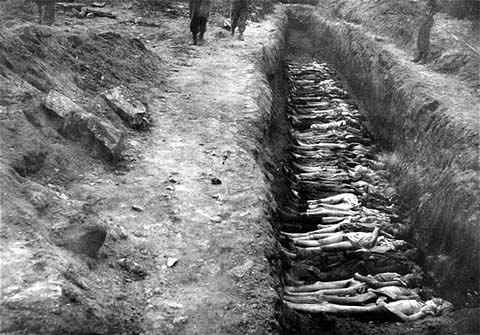 After the liberation of Mauthausen, the SS soldiers who had formerly guarded the camp were taken into custody; they were forced to work in the Mauthausen quarry, guarded by American soldiers, as shown in the photograph below. Some of the prisoners, who were Kapos or captains in charge of supervising other prisoners, were also arrested and charged with war crimes.  The photograph below shows former German prisoners and SS guards in the camp being forced to do deep knee bends for the amusement of the American liberators and the surviving Communist political prisoners. Note that three of the men have had a strip of hair shaved from the middle of their heads. This was done by the Nazis in the camps in an effort to control lice which spreads disease. Prisoners were customarily given haircuts in which the sides of the head were shaved, and for their next haircut, the middle of their head would be shaved. Note the survivors wearing dark caps or berets. Communist prisoners were allowed to wear civilian clothes and blue workers' caps to distinguish them from the other prisoners who wore striped caps to match their striped prison uniforms. The prisoners with the weird haircuts were probably German criminals who were Kapos, assigned to supervise the other prisoners. After the war, staff members of the Mauthausen camp, including two of the kapos, were brought before an American military tribunal at Dachau and convicted as war criminals. 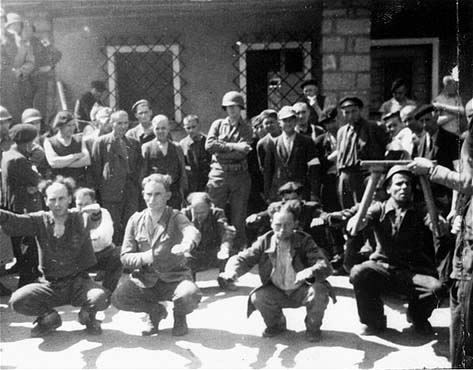 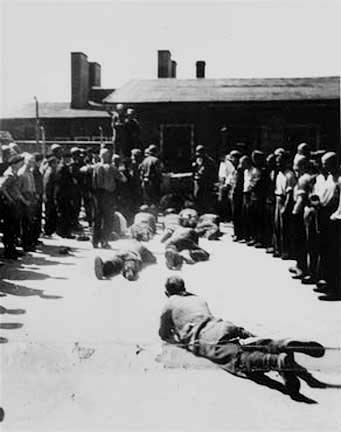 Note the position of the shadows in the two photographs above, which indicate that this humiliation of the former German guards and Kapos went on for several hours. None of the above photos is shown at the Mauthausen Museum, which tells nothing about what happened to the camp staff after the liberation, except for a display about the proceedings against selected members of the Mauthausen staff in an American Military Tribunal at Dachau. After the Mauthausen main camp and the sub-camps were liberated, the American military had until July 1945 to illegally remove machinery from the underground munitions factories before the camps had to be turned over to the Soviet Union on July 28, 1945, by prior agreement. On September 10, 1945, the Soviets began taking equipment from the Gusen underground factory where the Nazis had been building Messerschmitt jet airplanes. The removal of the machinery was completed by December 21, 1946. In July 1947, the final transport of equipment from Gusen to the Soviet Union was completed. On November 15, 1947, the tunnels where the factories were located at Gusen were destroyed by the Soviets. The former main camp at Mauthausen became a camp for Displaced Persons who were waiting to emigrate to other countries after the war. The Soviet Union also took charge of the quarry at Gusen and continued to take stone from it, operating under a company called Granitewerke Gusen. In 1955, the Allied occupation of Austria ended and the Soviets moved out; the railroad and the station at Gusen were dismantled. The property that remained after the Soviets left was given to the Austrian people. In the late 1950ies, the land in the Gusen area was privatized and private homes were built where the camps used to be. PreviousBack to Mauthausen indexHomeThis page was last updated on December 30, 2007 |